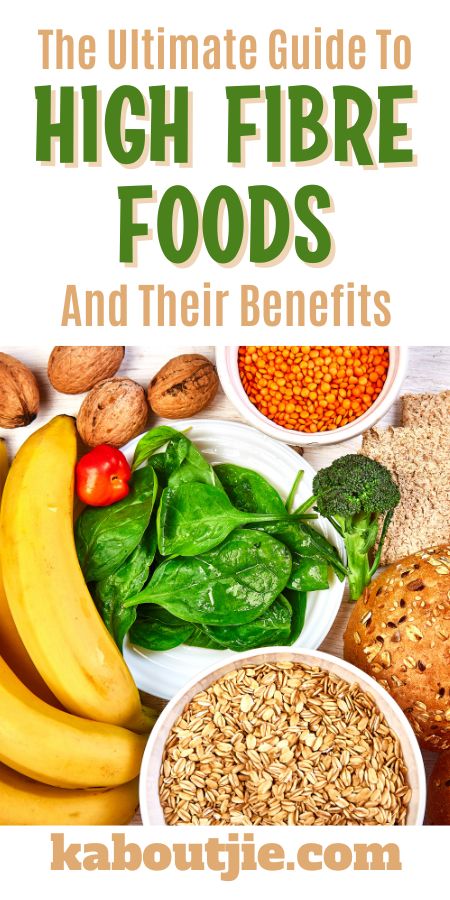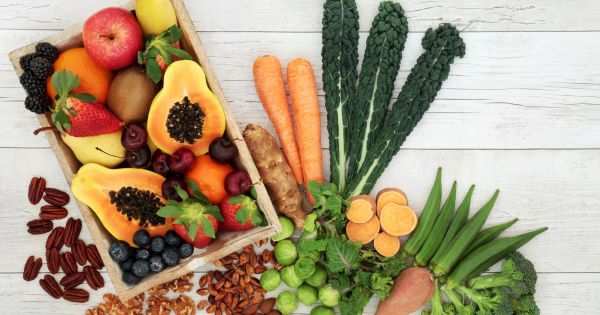If you’re looking to improve your overall health and wellbeing, adding high fibre foods to your diet is a great place to start. These foods can help with weight management, improve digestion, and even reduce the risk of certain diseases. In this ultimate guide, we’ll explore the benefits of high fibre foods and provide tips on how to incorporate them into your daily diet.
***Disclosure -The links in this post may contain affiliate links and I may receive a small commission if you make a purchase after clicking on a link.***

What Is Fibre And Why Is It Important?
Fibre is a type of carbohydrate that the body cannot digest. Instead, it passes through the digestive system relatively intact, providing a range of health benefits. Fibre is important for maintaining healthy bowel function, reducing the risk of chronic diseases such as heart disease and diabetes, and promoting feelings of fullness and satiety. There are two types of fibre: soluble fibre, which dissolves in water and forms a gel-like substance in the digestive tract, and insoluble fibre, which does not dissolve in water and helps to move food through the digestive system.
Types Of Fibre And Their Benefits
As mentioned, there are two types of fibre: soluble and insoluble. Soluble fibre can help lower cholesterol levels, regulate blood sugar levels, and promote feelings of fullness. Good sources of soluble fibre include oats, beans, peas, lentils, and fruits such as apples and oranges. Insoluble fibre, on the other hand, can help prevent constipation and promote regular bowel movements. Good sources of insoluble fibre include whole grains, nuts, seeds, and vegetables such as broccoli and carrots. By incorporating both types of fibre into your diet, you can reap the many health benefits they offer.
How Much Fibre Should You Be Eating Each Day?
The recommended daily fibre intake varies depending on age, gender, and other factors. It is recommended that adult females consume a minimum of 25g of fibre daily, while men should aim for 38g of fibre per day. For children, a general guideline is to consume their age plus 5g of fibre per day. However, most people only consume around half of that amount. It’s important to gradually increase your fibre intake to avoid digestive discomfort and to drink plenty of water to help the fibre move through your system.
It is important to note that not all food products containing “wholegrains” are high in fibre, so it is best to check the fibre content on the food label. A food is considered high in fibre if it contains 6g of fibre per 100g of the product. It is recommended to aim for at least 3g of fibre per serving.

Tips For Incorporating More Fibre Into Your Meals
There are many simple ways to add more fibre to your diet. Start by swapping out refined grains for whole grains, such as brown rice, quinoa, and whole wheat bread. Add beans, lentils, and chickpeas to soups, salads, and stir-fries. Snack on fruits and vegetables, such as apples, pears, carrots, and celery, instead of processed snacks. And don’t forget about nuts and seeds, which can be added to oatmeal, salads, yoghurt, and smoothies for an extra boost of fibre. By making these small changes, you can increase your fibre intake and improve your overall health.
High Fibre Fruits And Vegetables
- Avocado is a high-fiber fruit that is also rich in healthy fats. One medium-sized avocado contains about 10 grams of fiber, making it an excellent choice for those looking to increase their fiber intake.
- Artichokes are a great source of fiber, with one medium-sized artichoke containing around 10 grams of fiber. They are also rich in antioxidants and other nutrients that promote good health.
- Broccoli is a cruciferous vegetable that is high in fiber and other important nutrients. One cup of cooked broccoli contains around 5 grams of fiber, making it a great addition to any diet.
- Berries, such as raspberries, blackberries, and strawberries, are high in fiber and antioxidants. One cup of raspberries contains around 8 grams of fiber, making them a great choice for those looking to increase their fiber intake.
- Carrots are a root vegetable that is high in fiber and other important nutrients. One medium-sized carrot contains around 2 grams of fiber, making them a great snack or addition to any meal.
- Lentils are a legume that is high in fiber and protein. One cup of cooked lentils contains around 16 grams of fiber, making them an excellent choice for those looking to increase their fiber and protein intake.
- Sweet potatoes are a root vegetable that is high in fiber and other important nutrients. One medium-sized sweet potato contains around 4 grams of fiber, making them a great addition to any meal.
Incorporating high-fiber fruits and vegetables into your diet can have numerous health benefits, including improved digestion, lower cholesterol levels, and a reduced risk of chronic diseases such as heart disease and diabetes.

High Fibre Cereals
- Oatmeal is a classic high-fiber cereal that is perfect for breakfast. It contains both soluble and insoluble fiber, which helps to keep you feeling full and satisfied throughout the morning. Oatmeal is also a good source of protein and complex carbohydrates, making it a great choice for athletes and active individuals.
- Bran flakes are another popular high-fiber cereal that is low in sugar and calories. They are made from wheat bran, which is the outer layer of the wheat kernel. Bran flakes are a good source of fiber, vitamins, and minerals, and can help to lower cholesterol levels and improve digestive health.
- All-Bran is a high-fiber cereal that is made from wheat bran and psyllium husk. It is a good source of both soluble and insoluble fiber, which helps to promote healthy digestion and regularity. All-Bran is also low in sugar and calories, making it a great choice for weight management.
- Shredded wheat is a high-fiber cereal that is made from whole wheat. It is a good source of fiber, vitamins, and minerals, and is low in sugar and calories. Shredded wheat is also a great choice for people who are looking to reduce their intake of processed foods and artificial ingredients.
- Fiber One is a popular high-fiber cereal that is made from wheat bran and psyllium husk. It is a good source of both soluble and insoluble fiber, and can help to lower cholesterol levels and improve digestive health. Fiber One is also low in sugar and calories, making it a great choice for weight management.
- Kashi GoLean is a high-fiber cereal that is made from whole grains, soy protein, and fiber. It is a good source of protein, fiber, vitamins, and minerals, and can help to promote healthy digestion and regularity. Kashi Go Lean is also low in sugar and calories, making it a great choice for weight management.
- Quaker High Fiber Instant Oatmeal is a convenient and delicious way to get your daily dose of fiber. It is made from whole grain oats and contains both soluble and insoluble fiber, which helps to keep you feeling full and satisfied throughout the morning. Quaker High Fiber Instant Oatmeal is also low in sugar and calories, making it a great choice of high fibre foods for weight management.
High Fibre Foods For Weight Loss
- Oats are a great source of fiber and are perfect for breakfast. They are low in calories and high in fiber, which helps to keep you feeling full for longer periods of time. Oats can be eaten in many different ways, such as oatmeal, granola, or even in smoothies.
- Berries are a great source of fiber and are low in calories. They are also high in antioxidants, which help to protect your body from damage caused by free radicals. Berries can be eaten as a snack, added to smoothies, or used as a topping for yogurt or oatmeal.
- Legumes, such as lentils, chickpeas, and black beans, are high in fiber and protein. They are also low in fat and calories, making them a great addition to any weight loss diet. Legumes can be added to salads, soups, or used as a meat substitute in dishes like chili or tacos.
- Whole grains, such as brown rice, quinoa, and whole wheat bread, are high in fiber and can help to keep you feeling full for longer periods of time. They are also low in calories and can be used in many different dishes, such as salads, stir-fries, or as a side dish.
- Nuts and seeds are high in fiber and healthy fats, which can help to keep you feeling full and satisfied. They are also a great source of protein and can be added to salads, oatmeal, or eaten as a snack.
- Vegetables are low in calories and high in fiber, making them a great addition to any weight loss diet. They can be eaten raw, cooked, or used in soups and stews. Some high-fiber vegetables include broccoli, Brussels sprouts, and sweet potatoes.
- Fruits are a great source of fiber and are low in calories. They are also high in vitamins and minerals, which are important for overall health. Fruits can be eaten as a snack, added to smoothies, or used as a topping for yogurt or oatmeal. Some high-fiber fruits include apples, pears, and bananas.

5 Delicious High Fibre Recipes For Weight Loss
If you’re trying to lose weight, incorporating high fibre foods into your diet can be a great way to stay full and satisfied while also promoting healthy digestion. Here are five delicious and nutritious recipes that are packed with fibre and perfect for weight loss.
Quinoa And Black Bean Salad
This quinoa and black bean salad is a delicious and filling meal that’s perfect for lunch or dinner. Quinoa is a great source of protein and fibre, while black beans are packed with protein and other essential nutrients. To make this salad, simply cook quinoa according to package instructions and mix with black beans, diced tomatoes, diced red onion, chopped cilantro, and a simple dressing made with olive oil, lime juice, and cumin. Serve chilled or at room temperature for a tasty and healthy meal.
Roasted Vegetable And Chickpea Bowl
This roasted vegetable and chickpea bowl is a delicious and nutritious meal that’s perfect for lunch or dinner. Roasting the vegetables brings out their natural sweetness and adds a depth of flavor to the dish. To make this bowl, simply roast a mix of your favorite vegetables (such as sweet potatoes, broccoli, and bell peppers) with olive oil and spices, then add in some chickpeas for protein. Serve over a bed of quinoa or brown rice for a filling and satisfying meal.
Lentil And Vegetable Soup
This hearty lentil and vegetable soup is packed with fiber and nutrients, making it a perfect meal for weight loss. To make this soup, sauté onions, carrots, and celery in olive oil until softened, then add in lentils, diced tomatoes, vegetable broth, and your favorite spices. Let the soup simmer until the lentils are tender, then add in chopped kale or spinach for an extra boost of fiber and vitamins. Serve hot with a slice of whole grain bread for a satisfying and healthy meal.
Grilled Chicken And Vegetable Skewers
These grilled chicken and vegetable skewers are a delicious and healthy meal option for weight loss. Simply marinate chicken breast in a mixture of olive oil, lemon juice, garlic, and your favorite herbs and spices. Thread the chicken onto skewers with your favorite vegetables, such as bell peppers, zucchini, and onions. Grill until the chicken is cooked through and the vegetables are tender and slightly charred. Serve with a side salad for a complete and satisfying meal.
Sweet Potato And Black Bean Enchiladas
These sweet potato and black bean enchiladas are a delicious and filling meal that is perfect for weight loss. Simply roast diced sweet potatoes with black beans, onions, and spices until tender. Then, wrap the mixture in corn tortillas and top with enchilada sauce and shredded cheese. Bake until the cheese is melted and bubbly. Serve with a side of brown rice and a green salad for a complete and satisfying meal.
Potential Side Effects Of Consuming Too Much Fibre
While consuming high fibre foods is generally considered beneficial for health, consuming too much fibre can have some potential side effects. These can include bloating, gas, abdominal discomfort, and diarrhea. It’s important to gradually increase your fibre intake and drink plenty of water to help your body adjust. If you experience persistent discomfort or digestive issues, it’s best to consult with a healthcare professional.
 Kaboutjie SA Mommy Blogs by Lynne Huysamen
Kaboutjie SA Mommy Blogs by Lynne Huysamen




